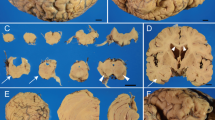Abstract
Lack of frataxin in Friedreich’s ataxia (FRDA) causes a complex neurological and pathological phenotype. Progressive atrophy of the dentate nucleus (DN) is a major intrinsic central nervous system lesion. Antibodies to neuron-specific enolase (NSE), calbindin, glutamic acid decarboxylase (GAD), and vesicular glutamate transporters 1 and 2 (VGluT1, VGluT2) allowed insight into the disturbed synaptic circuitry of the DN. The available case material included autopsy specimens of 24 patients with genetically defined FRDA and 14 normal controls. In FRDA, the cerebellar cortex revealed intact Purkinje cell somata and dendrites as assessed by calbindin immunoreactivity. The DN, however, displayed severe loss of large NSE-reactive neurons. Small neurons remained intact. Labeling of Purkinje cells, basket fibers, Golgi neurons, and Golgi axonal plexuses with antibodies to GAD indicated normal intrinsic circuitry of the cerebellar cortex involving γ-aminobutyric acid (GABA). In contrast, the DN displayed severe loss of GABA-ergic terminals and formation of GAD- and calbindin-reactive grumose degeneration. The surviving small GAD-positive DN neurons provided normal GABA-ergic terminals to intact inferior olivary nuclei. The olives also received normal glutamatergic terminals as shown by VGluT2-reactivity. VGluT1-immunocytochemistry of the cerebellar cortex confirmed normal glutamatergic input to the molecular layer by parallel fibers and the granular layer by mossy fibers. VGluT2-immunoreactivity visualized normal climbing fibers and mossy fiber terminals. The DN, however, showed depletion of VGluT1- and VGluT2-reactive terminals arising from climbing and mossy fiber collaterals. The main functional deficit underlying cerebellar ataxia in FRDA is defective processing of inhibitory and excitatory impulses that converge on the large neurons of the DN. The reason for the selective vulnerability of these nerve cells remains elusive.






Similar content being viewed by others
References
Campuzano V, Montermini L, Moltò MD et al (1996) Friedreich’s ataxia: autosomal recessive disease caused by an intronic GAA triplet repeat expansion. Science 271:1423–1427
Chan-Palay V (1977) Cerebellar dentate nucleus. Organization, cytology and transmitters. Springer, Berlin
De Zeeuw CI, Holstege JC, Calkoen F, Ruigrok TJH, Voogd J (1988) A new combination of WGA-HRP anterograde tracing and GABA immunocytochemistry applied to afferents of the cat inferior olive at the ultrastructural level. Brain Res 447:369–375
De Zeeuw CI, Ruigrok TJH, Schalekamp MPA, Boesten AJP, Voogd J (1990) Ultrastructural study of the cat hypertrophic inferior olive following anterograde tracing, immunocytochemistry, and intracellular labeling. Eur J Morphol 28:240–255
Foix C, Chavany J-A, Hillemand P (1926) Le syndrome myoclonique de la calotte. Etude anatomo-clinique du nystagmus du voile et des myoclonies rythmiques associées, oculaires, faciales, etc. Rev Neurol 1:942–956
Fredette BJ, Mugnaini E (1991) The GABAergic cerebello-olivary projection in the rat. Anat Embryol 184:225–243
Fremeau RT, Troyer MD, Pahner I et al (2001) The expression of vesicular glutamate transporters defines two classes of excitatory synapse. Neuron 31:247–260
Guillain G, Mollaret P (1931) Deux cas de myoclonies synchrones et rythmées vélo-pharyngo-laryngo-oculo-diphragmatiques: Le problème anatomique et physiologique. Rev Neurol 2:545–566
Herzog E, Bellenchi GC, Gras C et al (2001) The existence of a second vesicular glutamate transporter specifies subpopulations of glutamatergic neurons. J Neurosci 21:1–6
Hioki H, Fujiyama F, Taki K (2003) Differential distribution of vesicular glutamate transporters in the rat cerebellar cortex. Neuroscience 117:1–6
IIzuka R, Hirayama K, Maehara K (1984) Dentato-rubro-pallidoluysian atrophy: a clinicopathological study. J Neuro Neurosurg Psychiatry 47:1288–1298
Kaneko T, Fujiyam F, Hioki H (2002) Immunohistochemical localization of candidates for vesicular glutamate transporters in the rat brain. J Comp Neurol 444:39–62
Koeppen AH, Dickson AC, Lamarche JB, Robitaille Y (1999) Synapses in the hereditary ataxias. J Neuropathol Exp Neurol 58:748–764
Koeppen AH, Morral JA, McComb RD, Feustel PJ (2011) The neuropathology of late-onset Friedreich’s ataxia. Cerebellum 10:96–103
Lang EJ, Sugihara I, Llinás R (1996) GABAergic modulation of complex spike activity by the cerebellar nucleoolivary pathway in rat. J Neurophysiol 76:255–275
Lang EJ (2001) Organization of olivocerebellar activity in the absence of excitatory glutamatergic input. J Neurosci 21:1663–1675
Lapresle J, Ben Hamida M (1970) The dentato-olivary pathway. Arch Neurol 22:135–143
Mott FW (1907) Case of Friedreich’s disease, with autopsy and systematic microscopical examination of the nervous system. Arch Neurol Psychiat (Lond) 3:180–200
Mugnaini E, Oertel W (1981) Distribution of glutamate decarboxylase positive neurons in the rat cerebellar nuclei. Soc Neurosci Abstr 7:122
Nelson B, Mugnaini E (1985) Loss of GABAergic nerve terminals in the inferior olive of cerebellectomized rats. Soc Neurosci Abstr 11:182
Oppenheimer DR (1979) Brain lesions in Friedreich’s ataxia. Can J Neurol Sci 6:173–176
Owens DF, Kriegstein AR (2002) Is there more to GABA than synaptic inhibition? Nat Rev Neurosci 3:715–727
Robitaille Y, Lopes-Cendes I, Becher M, Rouleau G, Clark AW (1997) The neuropathology of CAG repeat diseases: Review and update of genetic and molecular features. Brain Pathol 7:901–927
Rossi F, Gianola S, Corvetti L (2006) The strange case of Purkinje axon regeneration and plasticity. Cerebellum 5:174–182
Ruigrok TJ, De Zeew CI, Voogd J (1990) Hypertrophy of inferior olivary neurons: a degenerative, regenerative or plasticity phenomenon. Eur J Morphol 28:224–239
Schaffer K (1915) Gibt es eine cerebello-olivare Bahn? Zeitsch Ges Neurol Psychiat 30:70–83
Shinoda Y, Sugiuchi Y, Futami T, Izawa R (1992) Axon collaterals of mossy fibers from the pontine nucleus in the cerebellar dentate nucleus. J Neurophysiol 67:547–560
Shinoda Y, Sugihara I, Wu H-S, Sugiuchi Y (2000) The entire trajectory of single climbing and mossy fibers in the cerebellar nuclei and cortex. In: Gerrits NM, Ruigrok TJH, De Zeeuw CI (eds) Progress in Brain Res. vol 124, pp 173–186
Urich H, Norman RM, Lloyd OC (1957) Suprasegmental lesions in Friedreich’s ataxia. Confin Neurol 17:360–371
Acknowledgments
The authors receive financial support from Friedreich’s Ataxia Research Alliance; National Ataxia Foundation; National Institutes of Health; and Neurochemical Research, Inc. The work was completed in the laboratories of the Research Service at the Veterans Affairs Medical Center in Albany, NY, USA.
Author information
Authors and Affiliations
Corresponding author
Rights and permissions
About this article
Cite this article
Koeppen, A.H., Davis, A.N. & Morral, J.A. The cerebellar component of Friedreich’s ataxia. Acta Neuropathol 122, 323–330 (2011). https://doi.org/10.1007/s00401-011-0844-9
Received:
Revised:
Accepted:
Published:
Issue Date:
DOI: https://doi.org/10.1007/s00401-011-0844-9




